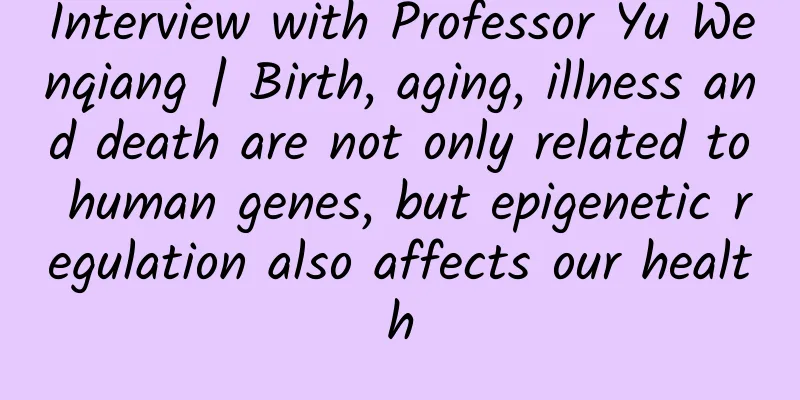Interview with Professor Yu Wenqiang | Birth, aging, illness and death are not only related to human genes, but epigenetic regulation also affects our health

|
Introduction: As the saying goes, "One mother gives birth to nine sons, and each of them is different." It can be seen that the acquired environment has a profound impact on children. In fact, even identical twins have the same genes, but their personalities and physical signs are often very different. This is closely related to epigenetics. In addition, different eating habits and lifestyles can also affect our health through epigenetic regulation. The guest we are interviewing today is Professor Yu Wenqiang, a researcher at the Institute of Biomedical Sciences of Fudan University and executive deputy director of the Institute of Genomics and Epigenomics. Professor Yu Wenqiang is a senior expert in the field of epigenetics in my country. He recently edited a monograph on "Epigenetics". Through this interview, we understand what epigenetics is? What interesting life phenomena is it related to? How does epigenetics affect our health and disease? 01 The difference between epigenetics and classical genetics Ye Shuisong : Can you tell me what epigenetics is ? How is it different from classical genetics ? Yu Wenqiang: In a word, epigenetics is a bridge between our body and the external environment. When it comes to genetics or epigenetics, there are actually some good examples to explain. For example, we often say "you reap what you sow." This is definitely a genetics problem. Another example is "a dragon gives birth to a dragon, a phoenix gives birth to a phoenix, and a mouse's child will dig holes." This can also be considered a genetics problem. Regarding genetics or epigenetics, I think a more extreme example can explain the difference between genetics and epigenetics. The word epigenetics itself is called "epigenetics", and "epi" means "on top of something". For example, the most extreme example is human cloning. You want to clone yourself. After cloning, you are the same from a genetic point of view, but the result is that you are different from the original you. This is because you were originally in your mother's womb, and the cloned you may be in a different environment. The birth environment decades ago and the new birth environment are completely different, and the education environment is also completely different. So from this perspective, you may clone your genes, but you can never copy yourself. So sometimes we often say that genetics talks about things between different species, such as mice giving birth to mice, monkeys giving birth to monkeys. But epigenetics talks about a person, you can only be yourself, no one else can be the same as you, even if they are cloned. Some people ask whether spiders are born with the ability to weave webs or learn it later in life? We put spiders in a place where they cannot see how other spiders weave webs, and they can still weave webs. Although they are not as beautiful as other spiders, they still have the ability to weave webs. Genetics determines many different things about species, as well as some innate skills. Epigenetics can modify these skills to make them more refined and different, so the two are completely different. You can think of genetics as the differences between species, and epigenetics as shaping the individual differences between the same species, which is very much related to the environment. The concept of epigenetics first emerged in the 1930s. It refers to the impact of the environment on species. For example, can the traits produced by the impact of the environment on plants be inherited? Later, it was discovered that such traits can be inherited, so the word "epigenetics" was derived. In fact, epigenetics first mentioned the question of whether the characteristics of some species can be inherited after being changed by environmental factors. 02 Physiological phenomena of epigenetics Ye Shuisong : What interesting physiological phenomena are related to epigenetics ? Yu Wenqiang: There are many examples of some very important phenomena in epigenetics. For example, there is a very important concept of gene imprinting in epigenetics. Why does the birth of a person require the combination of genes from both the father and the mother? From a genetic perspective, the father provides half of the DNA and the mother provides half of the genetic material. Providing two copies of DNA from different people at the same time can become a biological individual. The DNA provided by the father or the mother may be the same, but their epigenetics are different. For example, gene imprinting, some genes must be expressed from the father, and some genes must be expressed from the mother. Although the DNA provided by the father and mother is the same, their epigenetics are different, so a complete individual can be formed. In other animals, such as mice, we can change some epigenetic things, such as gene imprinting, so that they can reproduce parthenogenetically. However, in general, it is impossible under normal physiological conditions. It must have the combination of genes from the father and mother. Although the genetic material provided by the father and mother is the same, its epigenetic modification is different, so it plays different roles at different times. If these epigenetic problems occur, it will cause many diseases. This is why a person must have both a father and a mother to be born. There is another very important phenomenon that can be explained by epigenetics. The DNA in each of our cells actually comes from our parents. Liver cells and lung cells have the same DNA, but why do we still have differences between liver cells and lung cells? It is not because their DNA is different, but because of different epigenetic modifications. This also explains why epigenetics is very important. So from this perspective, the reason why each cell in our human tissues and organs is different is because different epigenetic regulation makes our cells different. Another question is about aging, for example, why do people age slowly? Theoretically, many genes may mutate from birth to now. However, the human body has 3 billion base pairs, and the chance of mutation should be very small. Epigenetic regulation is constantly changing, and it plays a very important role. 03 Epigenetic Phenomena in Nature Ye Shuisong : What interesting phenomena in nature can be explained by epigenetics ? Yu Wenqiang: For example, in nature, the relationship between worker bees and queen bees is that the queen bee is formed after the worker bees are born. If you feed it royal jelly, it will become a queen bee. If you feed it ordinary food, it will become a worker bee. From an environmental perspective, eating habits will also change its gender and function. Some time ago, someone studied the determination of species sex. We say that sex is determined by chromosomes. Males have Y chromosomes, while females do not. In fact, the change of sex in some species is very special, such as turtles, where temperature can change sex. Ye Shuisong : Epigenetics is closely related to the early diagnosis and treatment of diseases . How can we better use epigenetics to detect and treat diseases early ? Yu Wenqiang: This is actually the application of epigenetics. For example, I just talked about epigenetic modification, which includes gene methylation, histone modification, and non-coding RNA. In fact, from the stage of disease occurrence, epigenetics plays an important role, and epigenetic phenomena are reversible. Once genetic mutation occurs, it is very difficult to change the gene, but epigenetics includes gene methylation and histone modification, which are produced through the intervention of the external environment and are reversible, which provides us with a very important means and method for treatment. In addition, we often say that epigenetics can occur in the early or super early stages. Our understanding of a disease can be seen through morphology. For example, tumors may undergo some changes from the earliest stage of tumor carcinogenesis. Later, when tumors become cancerous, their epigenetic modifications undergo many changes, and there are many more changes in the metastasis stage. Anyway, epigenetics runs through the entire process of tumor onset. Early diagnosis is very important for tumor treatment. Early diagnosis can improve the 5-year survival rate. Recently, ultra-early diagnosis has been discovered, which can be used to diagnose a tumor before the pathology department considers it a tumor. The 5-year survival rate is very high both in China and abroad. The five-year survival rate of cancer in China is about half of that in the United States. If the cancer is diagnosed in the ultra-early stage, that is, in the early stage of the cancer, the five-year survival rate will be very high. From the perspective of epigenetics, ultra-early diagnosis, we know that some epigenetics may have undergone some changes in genes. From this perspective, the pan-cancer markers we have recently developed are very interesting. They can indeed be detected in the ultra-early stages of the tumor. Taking cervical cancer as an example, both low-grade lesions and high-grade lesions are called precancerous lesions, but low-grade lesions can often return to normal, while high-grade lesions have a high probability of becoming tumors. We found that methylation actually changes in high-grade lesions. In other words, through these tests we can generate early warning before the tumor occurs, and making a diagnosis may be very important. In addition, with some measures for early diagnosis, drug development will be more convenient. Because epigenetics is reversible, it can be removed through site-specific methylation, or some current epigenetic drugs, such as some HDAC, acetylase, deacetylase inhibitors, and DNA methylation and demethylase, have been used as drugs in diseases such as MDS myelodysplastic syndrome. We may need to do more work from the perspective of early diagnosis of diseases, and I think we will need to do more work from the perspective of treatment. We hope to have more methods and technologies for early diagnosis of diseases and also for some treatments of diseases. 04 Epigenetic drugs Ye Shuisong : Currently , many pharmaceutical companies are developing epigenetic drugs . Can you tell us more about this ? Yu Wenqiang: From the perspective of epigenetic drugs, drugs for gene methylation, such as some inhibitors of methylase, are a whole-genome demethylation. I think targeted demethylation is a future direction. In addition, the histone modification area includes LSD1 discovered by Professor Shi Yang of Oxford University, as well as various enzymes such as methylases, demethylases, acetylases, and deacetylases. Among them, drugs targeting methylases and demethylases are under development, and there is probably no drug on the market yet. However, these drugs are indeed used in clinical practice, and in the future, targeted methylation or demethylation drugs may be more meaningful. On the other hand, many companies are working on RNA drugs. For example, when siRNA molecules appeared, everyone thought that siRNA could be made into drugs, but after a long time, many problems were found. After the emergence of RNA vaccines, this problem has actually been solved, so RNA drugs have become very popular recently. At first, the best way for us to use compound drugs was to screen small molecule drugs and make a disease screen, but RNA drugs are different. I think small nucleic acid drugs are the third generation of drugs and the direction of future drug research. This is because the simplest way to develop small nucleic acid drugs is to pair bases. The way to pair is nothing more than to find a good target and then deliver it. So I think small nucleic acid drugs may be a very important direction in the future. For many diseases, I believe that our emerging domestic industries, domestic scientists, and the industry can seize these current good opportunities and do a lot of things. Epigenetics is one of the emerging fields that was developed relatively early in my country, and it is not at a disadvantage internationally. If we do it, we will be no worse than those abroad. So in this area, I hope everyone will invest more in research and development of small nucleic acid drugs and pay more attention to its development. Maybe we can make a drug with Chinese characteristics that is very effective for certain diseases. This article is a work supported by Science Popularization China Starry Sky Project Team/Author: Deep Science Reviewer: Tao Ning, Associate Researcher, Institute of Biophysics, Chinese Academy of Sciences Produced by: China Association for Science and Technology Department of Science Popularization Producer: China Science and Technology Press Co., Ltd., Beijing Zhongke Xinghe Culture Media Co., Ltd. |
<<: Can eating konjac help you lose weight? Pay attention to these two points!
>>: Breaking news! The Wenchuan mudslide has caused 4 deaths. How to deal with the mudslide?
Recommend
WeChat version updated to support the "New Year's Red Packet" function
WeChat 8.0.18 for iOS has been officially release...
The laser TV market is in a saddle-shaped decline, and how to break the situation has become an urgent matter
After years of rapid growth, it was thought that ...
Why do I hate Safari so much right now?
If there is one thing that developers hate the mo...
6 tips to improve push opening rate of APP!
The main purpose of push is to promote activation...
Watching a suspense drama actually made me ravenous! There are so many delicacies in "The Long Season"...
During the recent May Day holiday, the shoes of &...
R7s hands-on experience: rejecting the common face and being more popular
On October 20, 2015, OPPO held its autumn new pro...
Smart autumn harvest | Identify compound fertilizers and distinguish true from false at the speed of light
Produced by: Science Popularization China Author:...
Tik Tok account monetization strategy!
Now that you have fans and traffic, how do you mo...
How far away from the Milky Way disk can we see the entire Milky Way?
A friend asked: If the solar system moves slightl...
Foreign Academician Liu Ke: There are six misunderstandings about carbon neutrality. Electric vehicles are actually increasing carbon emissions.
Due to concerns about global carbon emissions, ma...
Red envelopes are rolling in! Have you used these new features of WeChat?
The Spring Festival is just a few days away, and ...
Acquiring new users: things operators should know
With the end of the mobile Internet traffic divid...
Two of my most memorable moments as a programmer
[[235144]] Last week, my colleagues and I had a q...









